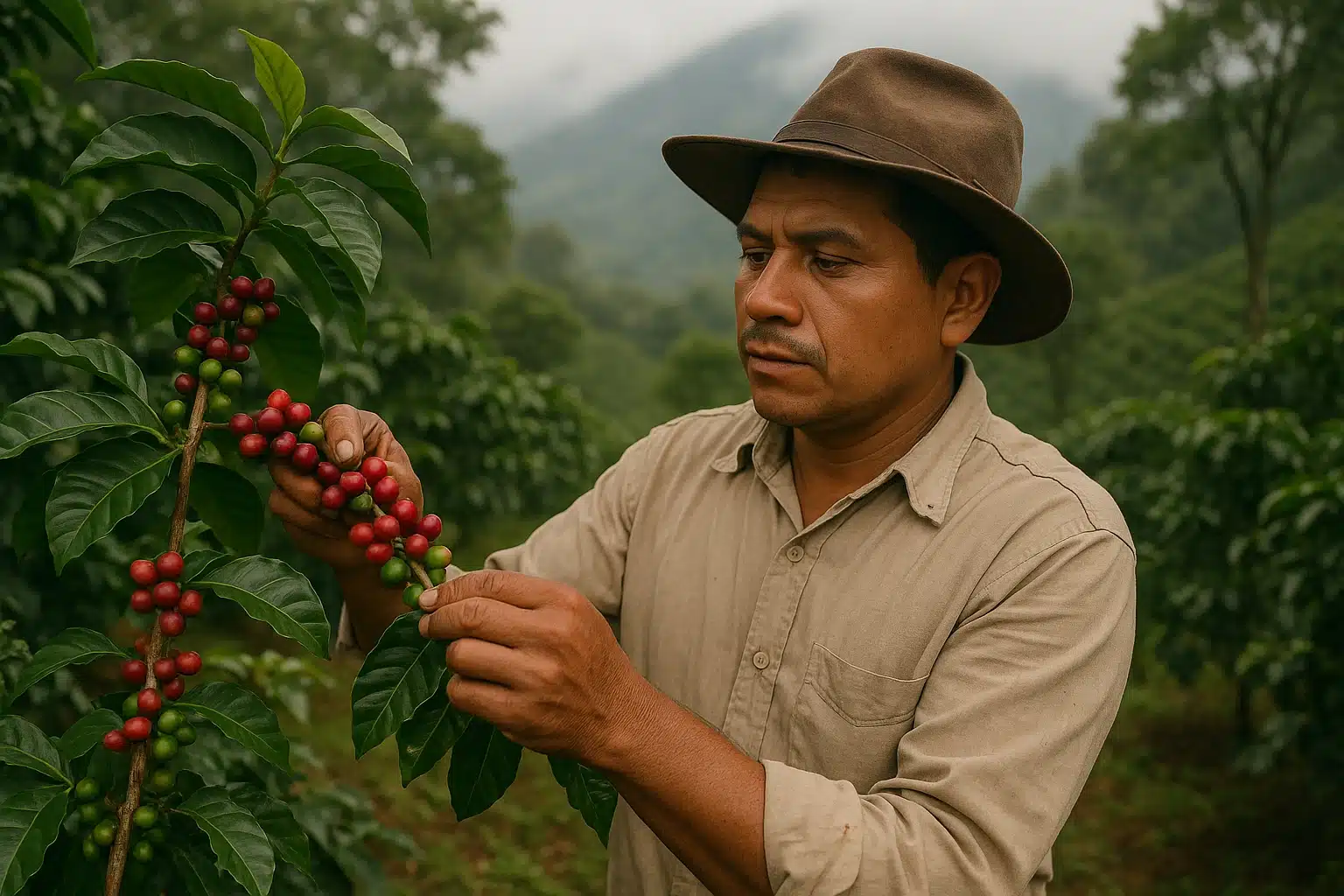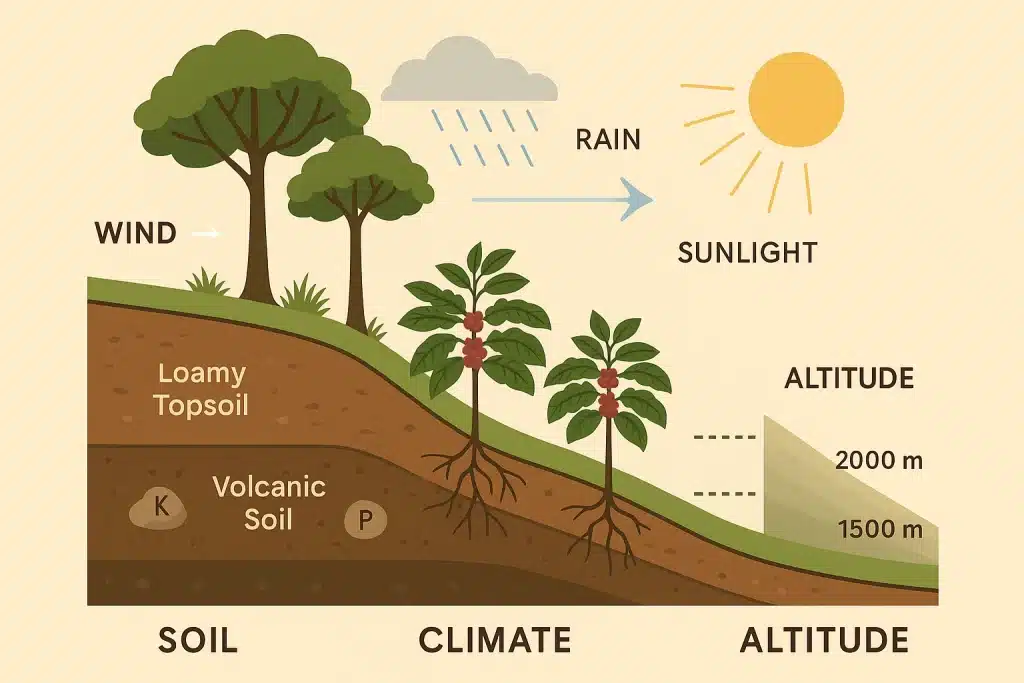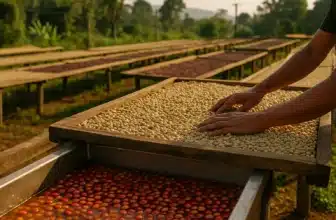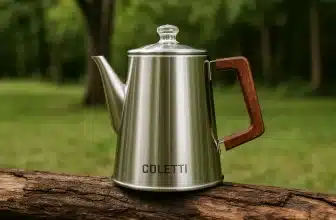
OneHundredCoffee is reader-supported, and some products displayed may earn us an affiliate commission. Details
I still remember the first time I tasted two coffees side-by-side that made me stop mid-sip and say, “Okay… something bigger is going on here.” Same roast level, same brew method, same water. One was bright and tea-like with lemon zest and jasmine; the other was velvety, dark-fruit sweet, almost like a spoonful of blackberry jam. That day, a barista friend grinned and said a word I’d heard tossed around but hadn’t truly felt: terroir.
If you’re searching for why coffees from one hillside sing with citrus while another valley whispers chocolate and nuts, this guide is for you. We’ll break down terroir in plain language, show how soil, climate, and altitude team up to shape flavor, and give you practical ways to taste those differences at home—no snobbery, just better cups.
What We Mean by “Terroir” (And Why It Matters)
Terroir is the complete natural environment where coffee grows: the soil beneath the roots, the altitude of the farm, the slope and direction the trees face, the wind patterns, the rainfall and dry spells, the daily temperature swings, the amount of shade, and even the way morning mist rolls in. Think of terroir as coffee’s accent—its native language. Variety (Bourbon, Typica, Geisha, etc.) is the voice; terroir is the accent.
Why it matters:
- It decides how fast cherries ripen, which affects sugar development and acidity.
- It influences bean density, a quiet force that affects how the coffee roasts and extracts.
- It contributes trace minerals and microbial life that steer flavor precursors before the roaster ever sees a green bean.
Roasting and processing matter a lot, of course. But terroir sets the stage. Get the stage right, and everything that follows has a better chance to shine.
The Big Three: Soil, Climate, and Altitude

Let’s keep this simple and practical. When you’re picking a bag of beans or trying to understand tasting notes, the big three cues are:
- Soil – The pantry of minerals and the home for roots and microbes.
- Climate – Temperature, rainfall, humidity, sun exposure, wind, and seasonality.
- Altitude – The quiet driver of ripening speed, bean density, and acidity.
Each component nudges coffee flavor in predictable ways. Here’s the friendly version of how to think about them.
Soil: The Ground Rules of Flavor
Soil isn’t just dirt; it’s a living ecosystem. The key things that matter are texture, drainage, organic matter, pH, and mineral content.
Volcanic Soils (Andisols)
- Where: Ethiopia, Guatemala, parts of Costa Rica, and Indonesia.
- Traits: Rich in minerals like potassium, phosphorus, and trace elements; great drainage; high organic matter.
- In the cup: Vivid acidity, structured body, and a clean, articulate flavor profile (think citrus, florals, stone fruit).
- How to brew: Filter methods (V60, Kalita) to show off clarity; don’t over-extract.
Clay-Rich Soils
- Where: Brazil’s Cerrado regions, parts of Colombia.
- Traits: Better water-holding capacity; can be nutrient-rich but needs good management.
- In the cup: Rounder body, chocolate, nutty, sometimes caramel sweetness.
- How to brew: Espresso and immersion (French press) can highlight the plush body.
Sandy/Loamy Soils
- Where: Parts of Central America, East Africa.
- Traits: Good drainage, faster warming; often used with organic mulches to maintain moisture.
- In the cup: Clean, sweet cups with approachable acidity; balanced and crowd-pleasing.
- How to brew: Great all-rounders—works for filter and espresso.
Limestone/Calcareous Influence
- Where: Pockets in Central America and the Caribbean.
- Traits: Alkaline tendencies; farmers often manage pH carefully.
- In the cup: Sometimes mineral brightness, delicate florals, and crisp finishes.
- How to brew: Lighter roasts with flat-bottom brewers to keep extraction even.
Quick rule: Better drainage and rich organic matter often produce cleaner, more articulate flavors. Heavier, water-logged soils can muffle nuance unless managed well (raised beds, mulching, smart irrigation).
Climate: The Rhythm Section Behind Your Favorite Notes

Climate is how the farm experiences weather over a season: temperature, rainfall patterns, sunlight, humidity, and wind. Coffee is sensitive to stress; the right stress at the right time can boost flavor.
Temperature & Daily Swings
- Cooler nights slow down cherry ripening, enhancing sugar accumulation and acidity.
- Warmer nights speed things up; beans can be less dense and tend to lower acidity.
Rainfall & Seasonality
- Distinct wet and dry seasons help coordinate flowering and uniform ripening.
- Too much rain close to harvest can dilute sweetness or invite disease; too little can stress trees and reduce yields—but also sometimes intensify flavor.
Sun vs. Shade
- Shade-grown coffee ripens more slowly: more complexity and sweetness, often with improved sustainability (bird habitat, biodiversity).
- Full sun pushes higher yield and sometimes bigger cherries, but can be harsher on trees; flavor can be simpler if not carefully managed.
Wind & Aspect
- Farms facing the morning sun (east-facing slopes) warm gently, reducing stress.
- Wind corridors keep foliage dry (good for disease control) but can desiccate if extreme.
Altitude: The Quiet Architect of Acidity and Density
Altitude is the simplest cue shoppers use—and with good reason. As altitude rises, temperature drops, and ripening slows. Slow ripening = more sugars, tighter cell structure, denser beans, and higher perceived acidity. But there’s a sweet spot; go too high and frost or extreme stress can cause defects or tiny yields.
Best Coffee Beans to Taste Terroir: Top Picks by Soil, Climate & Altitude

Who is this for?
Onyx Cold Brew Beans are for coffee lovers who want a smooth, bold cold brew at home. Designed specifically for cold extraction, these beans offer deep chocolatey notes with low acidity. Ideal for those who enjoy iced coffee daily or want café-quality results from their fridge, without sacrificing flavor or quality.Who is this for?
Blue Bottle Cold Brew is perfect for coffee lovers who enjoy smooth, low-acid iced coffee on demand. Pre-brewed and ready to drink, it suits busy mornings, office days, and travel. Crafted with quality beans, it offers a bold yet balanced taste with no bitterness—ideal for purists and casual drinkers alike.Who is this for?
Counter Culture’s Big Trouble blend is for coffee drinkers who love a bold, sweet, and nutty cup with low acidity. Perfect for drip, pour-over, or French press. Ethically sourced and roasted fresh, it’s great for anyone seeking a smooth, balanced brew with reliable flavor and quality in every sip.
Who is this for?
Intelligentsia Light Roast is crafted for coffee drinkers who seek bright, complex flavors in every cup. Ideal for pour-over or drip methods, this ground coffee offers notes of fruit and citrus with a smooth, clean finish. It’s perfect for those who appreciate artisan roasting and ethically sourced beans with character.
Who is this for?
Stumptown Trapper Creek Decaf is for coffee lovers who want rich, full flavor without the caffeine. Using the Swiss Water Process, it delivers smooth, chocolatey notes without chemicals. Ideal for pour-over, French press, or drip, it’s perfect for evening sips or those seeking a premium decaf with no compromise on taste.A Practical Altitude Cheat Sheet
| Altitude (masl) | Typical Cup Profile | Common Notes | Roast/Brew Tips |
|---|---|---|---|
| 600–1,000 | Lower acidity, broader body | Chocolate, nuts, mild fruit | Medium roast; great for espresso and milk drinks |
| 1,000–1,400 | Balanced acidity & sweetness | Caramel, red fruit, gentle citrus | Versatile; filter or espresso |
| 1,400–1,800 | Bright acidity, layered sweetness | Citrus, florals, stone fruit | Light–medium roast; pour-over to showcase clarity |
| 1,800+ | Highly articulate acidity, delicate aromatics | Bergamot, jasmine, tropicals | Light roast; careful extraction and cooler brew temps |
Real-world caveat: Altitude is not destiny. A 1,500 m farm with poor soil and erratic rain can taste less exciting than a 1,200 m farm with great soil, shade trees, and perfect processing. Terroir is a system, not a single number.
Variety Meets Terroir: Why “Same Variety, Different Place” Tastes Different
Varieties carry genetic potential (like a musician’s repertoire), but terroir decides how those songs sound on stage. Geisha (or Gesha) is the textbook example:
- Geisha in Panama (high altitude, volcanic soils): sparkling bergamot, jasmine, peach.
- Geisha in lower, warmer sites: still elegant, but the perfumed florals can soften; body rises and acidity relaxes.
The same patterns hold for SL28/SL34 in Kenya (often blackcurrant and tomato leaf brightness) and Bourbon in Rwanda (sweet red fruit, brown sugar). Variety is the vocabulary; soil, climate, and altitude write the poetry.
Processing Doesn’t Erase Terroir—It Amplifies or Edits It
Processing (washed, natural, honey, anaerobic) interacts with terroir like a post-production edit. It doesn’t change the script; it changes the emphasis.
- Washed: Cleans the stage. You taste altitude, soil transparency, and varietal purity. Great for high-altitude citrus-floral coffees.
- Natural: Adds a bassline of fruit and body. Works wonders with drier, sunny climates where clean drying is easy; can overshadow delicate florals if pushed too far.
- Honey/Pulped Natural: The middle road—sweetness boost with some clarity preserved.
- Anaerobic/Experimental: Bold flavors (spice, tropical ferment, winey tones). Fun, but if you want the personality of the place, look for producers who use these to complement terroir, not mask it.
Taste the Map: What Regions Typically Deliver
A few broad sketches (not rules, but helpful starting points):
- Ethiopia (Yirgacheffe, Guji, Sidama; high altitude, volcanic soils)
Bright florals, citrus, tea-like body. Washed coffees sing; naturals bring blueberry/tropical layers. - Kenya (Central Highlands; volcanic soils, cool nights)
Electric acidity, blackcurrant, tomato leaf, grapefruit clarity. Highly structured cups. - Colombia (Huila, Nariño, Tolima; varied altitudes, microclimates)
Balanced profiles from caramel and red fruit to citrusy florals at higher elevations. - Brazil (Cerrado, Sul de Minas; lower altitudes, clay-rich soils, sun)
Chocolate, nuts, toffee; easy-drinking, great for espresso blends. - Costa Rica & Guatemala (volcanic belts)
Clean sweetness, apple/stone fruit, nutty cocoa; honey processes show off caramelized sugars. - Yemen (ancient terraces, arid climate)
Dense, complex, winey fruit, spice; small lots, characterful naturals shaped by dry climate. - Panama (Boquete, Volcán; high altitude, volcanic)
Iconic Geisha aromatics—jasmine, bergamot, peach—when altitude and processing are dialed.
How to Buy Coffee If You Want to Taste Terroir
Here’s a shopper’s checklist that actually helps:
- Look for farm or micro-region detail. The more specific, the more likely you’re paying for intentional terroir expression.
- Check altitude and variety. This pair predicts acidity and fragrance well.
- Match process to your preference. Washed for clarity; natural/honey for extra fruit/body.
- Roast date matters. Fresh roasted (then rested ~5–12 days) keeps aromatics alive.
- Start with single origins before blends. It’s easier to trace terroir in a single-origin coffee.
How to Brew to Highlight Place
Brewing can either spotlight terroir or put a blanket over it. These tweaks make a difference:
- Use good water. If your tap tastes flat or harsh, use filtered water or a mineral recipe geared for coffee.
- Grind well and consistently. Uneven grind = muddled flavors.
- Dial the temperature of the coffee.
- High-altitude, light roasts: start at 94–96 °C (201–205 °F).
- Lower-altitude, medium roasts: start at 90–93 °C (194–199 °F).
- For clarity (Ethiopia/Kenya): use a conical or flat-bottom dripper, moderate flow, and avoid aggressive agitation late in the brew.
- For body (Brazil/Indonesia): go immersion (French press) or espresso; extend contact time slightly.
Pro move: Brew the same coffee two ways—one filter, one immersion—and taste how texture changes the perception of acidity and sweetness. Same terroir, different framing.
Troubleshooting: When Your Coffee Doesn’t Taste Like the Bag Promised
- Muted or flat: Check water, grind finer, increase dose slightly, or raise brew temp.
- Sour/underdeveloped: Grind finer or lengthen brew time; ensure water is hot enough.
- Bitter/over-extracted: Grind coarser, reduce agitation, or lower brew temp.
- No florals showing: Give the bag more rest days (light roasts often open up after a week), or switch to a paper filter for more clarity.
Sustainability and Terroir: Why Good Farming Protects Flavor

Flavor isn’t just a culinary joy; it’s a signal that a landscape is being well cared for.
- Shade trees protect soil moisture, encourage birds that control pests, and slow ripening for complexity.
- Mulch & cover crops stabilize soil temperatures and feed microbes, which support nutrient uptake.
- Thoughtful water use keeps plants unstressed in dry periods, preserving sweetness.
- Selective picking (ripe cherries only) respects the ripening curve terroir created.
When you pay for carefully grown, traceable coffee, you’re voting for the conditions that make the best flavors repeatable.
Quick Flavor Decoder: Soil, Climate, Altitude at a Glance
| Factor | If You See… | Expect… | Try… |
|---|---|---|---|
| Soil | Volcanic, rich organic matter | Crisp acidity, clarity | Distinct dry/wet seasons, shade-grown |
| Climate | Distinct dry/wet seasons, shade grown | Sweet, layered cups | Honey-processed Costa Rica |
| Altitude | 1,600–2,000+ masl | High aromatics, tea-like body | Light roast, V60/Kalita |
| Lower Altitude | 600–1,000 masl, sunny | Round body, chocolate/nut | Espresso, French press |
| Processing | Natural/anaerobic in dry climates | Berry/tropical, heavier body | Lower brew temp to tame fermenty notes |
Myth-Busting: Terroir Edition
- Myth: “High altitude automatically equals better coffee.”
Reality: Often brighter and more complex—but farm health, soil care, and processing still decide the outcome. - Myth: “Processing determines all flavor.”
Reality: Processing shapes, but terroir supplies the raw materials. A well-grown washed coffee can be more expressive than a flashy anaerobic done poorly. - Myth: “All volcanic coffees taste the same.”
Reality: Elevation, rainfall pattern, and variety create endless diversity on volcanic soils.
A Friendly Tasting Routine to Train Your Palate
- Pick two coffees from different terroirs (e.g., Ethiopia Yirgacheffe washed vs. Brazil Cerrado natural).
- Brew both with the same method, dose, and water.
- Smell first, then sip when warm and when cool—aromatics bloom as temperature drops.
- Write three words for each (don’t overthink it): a body word, an acidity word, and a flavor word.
- Swap brew methods next round and repeat.
After a few sessions, you’ll “hear” terroir details you never noticed before.
FAQ: Short Answers to Common Questions
What is coffee terroir?
It’s the sum of natural factors—soil, climate, altitude, slope, shade, wind—that shape how coffee grows and, ultimately, tastes in the cup.
Does altitude really change flavor?
Yes. Higher altitudes slow ripening, building sugars and acidity, and usually produce denser beans with brighter, more complex flavors.
Which soil is best for coffee?
There’s no single “best,” but volcanic soils with great drainage and organic matter often yield clean, vibrant cups. Good farm management can make other soils shine, too.
Why do Ethiopian coffees taste floral?
High altitudes, volcanic soils, and heirloom varieties combine for delicate aromatics and citrus-tea-like profiles—especially in washed lots.
Is natural-processed coffee more “terroir-true” than washed?
Not inherently. Washed often highlights place more transparently; naturals add layers of fruit and body that can complement or overshadow terroir, depending on execution.
How can I taste terroir at home?
Brew two single origins from contrasting regions using the same recipe. Use good water, weigh everything, and take notes warm and cool.
Does shade-grown matter for flavor?
Often yes—shade slows ripening and can boost complexity while supporting biodiversity.
If I like chocolatey coffee, what terroir should I look for?
Lower-to-mid altitudes with warmer, sunnier climates (Brazil, some Colombia and Central America regions) and soils with good water retention often deliver chocolate, nut, and caramel notes.
A Simple Buying Path Based on the Flavors You Love
- Citrus, florals, tea-like clarity → High-altitude Ethiopia (washed), Kenya (washed), Panama Geisha.
- Berry, tropical fruit, jammy sweetness → Ethiopia or Yemen naturals, Central American naturals from dry microclimates.
- Chocolate, nuts, caramel comfort → Brazil Cerrado/Sul de Minas, Guatemala medium altitudes, Colombia mild regions.
- Apple, stone fruit, balanced cups → Guatemala Antigua/Huehuetenango, Costa Rica honey-processed, Colombia Huila.
Bringing It All Together (A Personal Note)

When I’m tasting a new coffee, I picture the hillside it came from. Not in a poetic way—more like a checklist. What’s under the trees? Volcanic gravel or red clay? How hot did afternoons get? Did the farmer plant shade trees or go for full sun? Is the farm catching cool mountain air at night? Those answers show up in the cup: the lift of the acidity, the shape of the body, the kind of sweetness that lingers when you’re already rinsing the dripper.
That’s terroir. It’s not mystical; it’s physical and practical—but the result feels a little magical. If you start reading bag labels for altitude, region, and process, and you brew thoughtfully, you’ll start predicting taste before the first sip. And that’s when coffee turns from a daily habit into a little adventure, one hillside at a time.
Quick Start: Taste Terroir Tonight
- Buy two single-origin coffees that name the farm or micro-region.
- Choose different altitudes or processes to exaggerate the contrast.
- Brew both with the same recipe (use a gram scale, please!).
- Note acidity, body, and aftertaste in three words each.
- Switch brew method tomorrow and see what changes.








